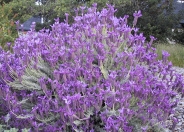
Common name: Spanish Lavender
Botanical name: Lavandula stoechas
This dense shrub grows 2'-3' tall with blue gray foliage and deep purple flowers that have large showy bracts near the top of the spikes. It is drought tolerant .
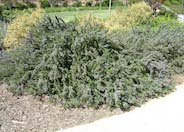
Common name: Rosemary
Botanical name: Rosmarinus officinalis
Rosemary is hardy in full sun areas where winter temperatures do not drop below 10 degrees F. Rosemary is evergreen and makes a great aromatic hedge, 4'-6' tall and 2' wide. Foliage is used in cooking. Blue flowers appear in summer. This plant is drought tolerant once it's established. Bees love Rosemary!
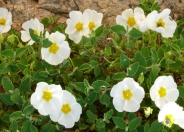
Common name: Sageleaf Rockrose
Botanical name: Cistus salviifolius
This low-spreading shrub reaches a size of 2' tall by 6'-8' wide. It bears white flowers that are 1" wide with yellow centers in spring and summer. This variety makes a good groundcover. The plant requires average to good drainage, and little or no summer watering when established. It should be grown in sun or part shade. Leaves are evergreen, gray green and sticky which release a perfume in heat. This shrub does best in full sun and tolerates coastal conditions. It is deer resistant.
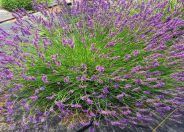
Common name: Grosso Long Stemmed Lavender
Botanical name: Lavandula x intermedia 'Grosso'
Long Stemmed Lavender has beautiful lavender colored plumes in the summer, reaching 3' tall and wide. Fragrance from blooms attract bees. Dried flowers used for sachets, oils, medicinal and culinary uses. Foliage is gray green and thin. This perennial has "fatter" flower spikes than other lavenders. It prefers full sun in well draining soil with low fertilizer. Does not tolerate frost or humidity.
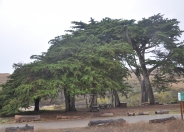
Common name: Monterey Cypress
Botanical name: Cupressus macrocarpa
Standing 40' tall and wide, bright green foliage highlights this tree. Ideal for planting on golf courses or near the coast, the Monterey Cypress spreads with age to shed its narrow and pyramidal structure of youth. The wind will shape the tree. It grows best in coastal habitats where it is not exposed to extreme heat or humidity. It does best in full sun with acidic, sandy, loam, clay soil that is well draining. It is drought tolerant once it's established. Also known as Hesperocyparis macrocarpa